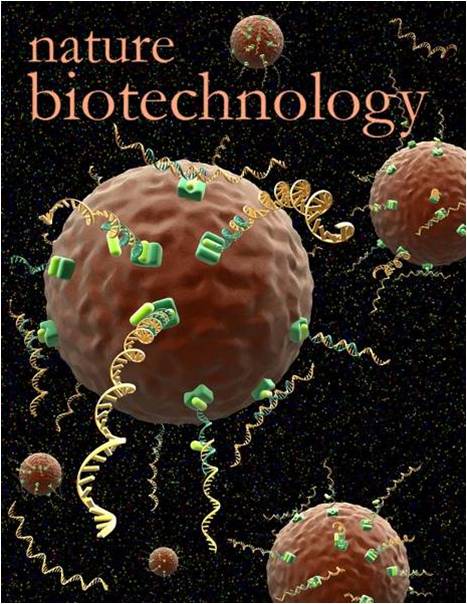Nature Biotechnology 2009年2月封面文章:
基于安捷伦寡核苷酸合成技术的液相序列捕获系统
高通量平行靶向测序的最佳解决方案

来自美国麻省理工学院和哈佛大学Broad研究院的研究人员,利用安捷伦(Agilent Technologies)卓越的寡核苷酸序列合成技术,合成大量生物素标记的RNA“诱饵”用于靶向序列的捕获,成功应用于高通量平行靶向测序。这一重大科学进展作为封面文章发表在最新一期的«自然•生物科技»杂志上。
下一代测序技术(Next Generation Sequencing)是对传统测序技术的革命性变革,可以一次完成数十万到数百万条DNA分子的序列测定,使得在极短时间内对人类转录组和基因组进行细致研究成为可能。2003年,“人类基因组计划”获得首张人类全基因组图谱,为了测定人类基因组的30亿对碱基,数以千计的科学家们花费了超过30亿美元和13年的时间。尽管与传统测序技术相比,下一代测序技术的成本大幅降低,但目前测序一套个人基因组图谱的成本仍然高达数十万美元。所以,在现阶段,如何实现对大批量样本的高通量平行靶向测序,对许多科学和医学研究课题具有重大意义。
为了实现这一目标,研究人员从生物芯片技术得到灵感,随机选择了1,900个人类基因,针对这些基因的15,565个编码蛋白的外显子序列(﹥2.5 Mb)以及另外4个基因组大片段序列(﹥1.7 Mb),根据tiling方法设计并且利用安捷伦的“SurePrint”技术合成了22,000条200-mers寡核苷酸探针。再经PCR和反转录后得到足够量的生物素标记的RNA“诱饵”,巧妙建立RNA-DNA的液相杂交系统,对全基因组DNA中的目的序列进行成功捕获,序列数据经由Illumina公司的测序仪读取。
测序结果表明:1)极佳的特异性:高达90%的读出序列来源于RNA“诱饵”捕获,其中和靶向序列完全重合的超过50%;2)优秀的均一性:对基因组大片段序列,至少和捕获序列重合一半以上的RNA“诱饵”超过80%,即使对小片段的外显子序列,这一数字也超过60%;3)卓越的重现性:2组技术重复试验间的差异率不到10-5;4)可以精确地检测SNP。综上所述,实验结果完美验证了基于液相序列捕获的高通量平行靶向测序技术的特异性,准确性,重现性和广泛的应用前景。
英文摘要:
Nature Biotechnology. 2009 Feb;27(2):182-9. Epub 2009 Feb 1.
Solution hybrid selection with ultra-long oligonucleotides for massively parallel targeted sequencing
Andreas Gnirke1, Alexandre Melnikov1, Jared Maguire1, Peter Rogov1, Emily M LeProust2, William Brockman1,5, Timothy Fennell1, Georgia Giannoukos1, Sheila Fisher1, Carsten Russ1, Stacey Gabriel1, David B Jaffe1, Eric S Lander1,3,4 & Chad Nusbaum1
Targeting genomic loci by massively parallel sequencing requires new methods to enrich templates to be sequenced. We developed a capture method that uses biotinylated RNA ‘baits’ to fish targets out of a ‘pond’ of DNA fragments. The RNA is transcribed from PCR-amplified oligodeoxynucleotides originally synthesized on a microarray, generating sufficient bait for multiple captures at concentrations high enough to drive the hybridization. We tested this method with 170-mer baits that target 415,000 coding exons (2.5 Mb) and four regions (1.7 Mb total) using Illumina sequencing as read-out. About 90% of uniquely aligning bases fell on or near bait sequence; up to 50% lay on exons proper. The uniformity was such that B60% of target bases in the exonic ‘catch’, and B80% in the regional catch, had at least half the mean coverage. One lane of Illumina sequence was sufficient to call high-confidence genotypes for 89% of the targeted exon space.
1Broad Institute of MIT and Harvard, 7 Cambridge Center, Cambridge, Massachusetts 02142, USA. 2Agilent Technologies Inc., 5301 Stevens Creek Blvd., Santa Clara, California 95051, USA. 3Department of Biology, Massachusetts Institute of Technology, 77 Massachusetts Ave., Cambridge, Massachusetts 02139, USA. 4Department of Systems Biology, Harvard Medical School, 200 Longwood Ave., Boston, Massachusetts 02115, USA. 5Present address: Google, Inc., 5 Cambridge Center, Cambridge, Massachusetts 02142, USA. Correspondence should be addressed to A.G. (gnirke@broad.mit.edu).
